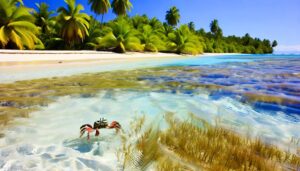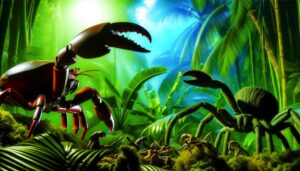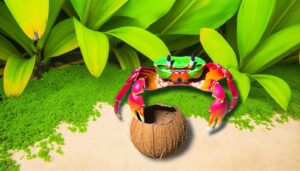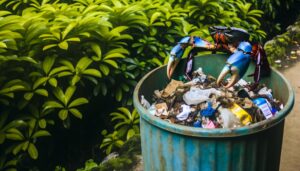Do Coconut Crabs Drink Salt Water or Fresh Water?
Coconut crabs (Birgus latro) can regenerate limbs through a process called autotomy followed by cellular proliferation. When a limb is lost, undifferentiated cells form a blastema at the wound site, guided by morphogen gradients.
Molting, regulated by ecdysteroids, is essential for this regeneration, allowing the crabs to shed and reform their exoskeleton. Younger coconut crabs exhibit faster regrowth due to higher molting frequency.
Environmental factors such as nutrient availability and temperature also influence regeneration efficiency. Understanding these mechanisms offers insights into regenerative biology and adaptive strategies of coconut crabs.
Explore further to discover the nuances of their remarkable recovery processes.

Key Takeaways
- Coconut crabs can regenerate lost limbs naturally through a process similar to other crustaceans.
- Regeneration involves blastema formation, cell proliferation, and differentiation guided by morphogen gradients.
- The regrowth process takes months to years, influenced by molting frequency and environmental factors.
- Regenerated limbs are fully functional, restoring the crab's mobility and foraging efficiency.
- Younger coconut crabs regenerate limbs faster compared to older individuals.
Coconut Crab Anatomy
Coconut crabs (Birgus latro) possess a robust exoskeleton, segmented bodies, and specialized appendages adapted for their terrestrial lifestyle. Their exoskeleton provides structural support and protection, essential for surviving on land. These crabs exhibit a cephalothorax and abdomen, with the cephalothorax housing crucial organs and sensory structures.
The first pair of appendages, known as chelae, are large and powerful, used for defense and manipulating food. Additionally, they've four pairs of walking legs, enabling efficient terrestrial locomotion. The posterior-most pair of legs is modified for climbing and handling objects. Their respiratory system includes branchiostegal lungs, allowing them to breathe air.
These anatomical adaptations collectively enable coconut crabs to thrive in their unique ecological niches.
Limb Loss in Crabs
Experiencing limb loss, crabs, including coconut crabs, often undergo autotomy, a self-amputation process that serves as a defensive mechanism against predators. Autotomy involves the deliberate shedding of a limb at a predetermined breakage point. This phenomenon is not random but a calculated survival strategy observed in various crustacean species.
Researchers have documented the following key aspects of limb loss in crabs:
| Factor | Description | Evidence |
|---|---|---|
| Autotomy Sites | Predetermined breakage points on limbs | Empirical studies on crustacean anatomy |
| Frequency | Occurs more frequently during predator encounters | Field observations |
| Survival Rate | Increases post-autotomy due to predator distraction | Comparative survival analyses |
| Energy Allocation | Redirected to wound healing and future regeneration | Physiological studies |
Understanding these mechanisms highlights the evolutionary adaptations crabs have developed for survival.
Regeneration Basics
Following autotomy, crabs exhibit remarkable regenerative capabilities, driven by intricate biological processes that restore lost limbs.
Cellular proliferation initiates within the wound site, forming a blastema—a mass of undifferentiated cells. This blastema undergoes differentiation, guided by morphogen gradients and signaling pathways such as Wnt and Hedgehog, necessary for limb patterning.
Empirical studies demonstrate that regeneration efficacy correlates with the crab's age and health status. Juvenile crabs regenerate limbs more efficiently due to their heightened cellular activity. Additionally, energy allocation plays a pivotal role; sufficient nutrient reserves expedite regeneration.
Importantly, the process culminates in the reformation of the exoskeleton, ensuring functional and structural integrity of the new limb. This regenerative phenomenon underscores the adaptive resilience of crabs in their natural habitats.
Molting Process
The molting process in crabs, an essential physiological mechanism, involves the shedding and subsequent regeneration of the exoskeleton to accommodate growth and repair.
This cyclical event, termed ecdysis, allows crabs to increase in size and mend damaged appendages. During molting, crabs secrete enzymes that degrade the old exoskeleton, facilitating its removal. Concurrently, a new, softer exoskeleton forms beneath.
Empirical studies have documented that hormonal regulation, primarily via ecdysteroids, orchestrates this complex process. Post-molt, the new exoskeleton hardens through sclerotization, providing structural integrity.
This period renders crabs vulnerable to predation and environmental stressors, underscoring the adaptive significance of their secluded molting behavior.
Understanding molting is pivotal in comprehending the regenerative capabilities observed in coconut crabs.
Cellular Mechanisms
Understanding the molting process sets the stage for examining the cellular mechanisms that drive appendage regeneration in coconut crabs.
Cellular regeneration involves a series of intricate biological processes. Key mechanisms include:
- Cell Proliferation: Regeneration initiates with rapid cell division to replace lost tissue.
- Differentiation: Cells specialize into various types necessary for forming complex structures like muscles and exoskeleton.
- Apoptosis: Controlled cell death eliminates damaged or unnecessary cells, ensuring proper tissue formation.
- Growth Factor Signaling: Specific proteins and hormones regulate cellular activities, orchestrating coordinated growth and differentiation.
Empirical studies have demonstrated these processes through histological examinations and gene expression analyses, confirming their roles in appendage regeneration.
Emphasizing these mechanisms provides a clearer understanding of how coconut crabs can regenerate lost limbs.
Factors Affecting Regrowth
Regrowth in coconut crabs is influenced by several factors, including nutritional status, molting frequency, and environmental conditions. Adequate nutrition is essential for energy-intensive regeneration processes. Higher molting frequency accelerates the formation of new appendages due to the periodic shedding of the exoskeleton. Ideal environmental conditions, such as suitable temperature and humidity levels, also play an essential role in successful regrowth.
| Factor | Influence on Regrowth |
|---|---|
| Nutritional Status | Provides necessary energy |
| Molting Frequency | Increases regrowth opportunities |
| Environmental Conditions | Ensures best regeneration |
| Age of Crab | Younger crabs regenerate faster |
| Injury Severity | Severe injuries may hinder regrowth |
These factors collectively dictate the efficiency and speed at which coconut crabs can regenerate lost appendages.
Comparison With Other Crabs
Coconut crabs exhibit remarkable regenerative capabilities. Yet, empirical evidence indicates variability compared to other crab species. For instance, while coconut crabs can regenerate lost limbs, the arm recovery time is notably longer than that of blue crabs (Callinectes sapidus) and fiddler crabs (Uca pugnax).
The relative differences in regeneration rates and efficiency highlight species-specific physiological adaptations.
Regeneration Capabilities Compared
Among crustaceans, the regeneration capabilities of coconut crabs (Birgus latro) exhibit remarkable efficiency, though they differ noticeably from those observed in other species such as the blue crab (Callinectes sapidus) and the fiddler crab (Uca spp.).
Comparative studies indicate several key differences:
- Regeneration Rate: Blue crabs regenerate limbs faster than coconut crabs, yet with less structural robustness.
- Molt-Dependent Regeneration: Coconut crabs exhibit a unique molt cycle dependency, unlike fiddler crabs which can regenerate independent of molting.
- Energy Allocation: Coconut crabs allocate more energy for regeneration during specific life stages compared to blue crabs.
- Morphological Precision: Fiddler crabs regenerate claws with high precision, while coconut crabs exhibit variable outcomes.
This comparison underscores the diverse evolutionary adaptations in limb regeneration among these species.
Arm Recovery Time
Examining the arm recovery time, coconut crabs demonstrate a notably prolonged period compared to the rapid limb regrowth observed in blue crabs and fiddler crabs. Empirical evidence indicates that coconut crabs can take several molts, spanning months to years, to fully regenerate a lost limb. In contrast, blue crabs and fiddler crabs often regenerate lost limbs within a single molting cycle, typically occurring in weeks to a few months. The disparity in recovery times can be attributed to differences in metabolic rates and molting frequencies among these species.
| Crab Species | Regrowth Time | Molting Frequency |
|---|---|---|
| Coconut Crab | Months-Years | Infrequent (annual) |
| Blue Crab | Weeks-Months | Frequent (biannual) |
| Fiddler Crab | Weeks-Months | Frequent (biannual) |
This table elucidates the contrasting regeneration timelines and molting patterns among these crabs.
Survival Advantages
Coconut crabs exhibit improved predatory defense through limb autotomy, which allows them to escape threats by shedding limbs and subsequently regenerating them. Empirical evidence suggests that this capability contributes notably to their high survival rates in predatory environments.
Additionally, their resourceful adaptation skills enable them to exploit a wide range of habitats and food sources, further ensuring their resilience and longevity.
Enhanced Predatory Defense
The remarkable ability of coconut crabs to regenerate lost limbs greatly enhances their predatory defense mechanisms, offering an essential survival advantage in their natural habitat. Empirical studies suggest that limb regeneration helps coconut crabs counteract predation and enhance their foraging efficiency.
This regenerative capability provides several defensive advantages:
- Enhanced Mobility: Regenerated limbs restore the crab's ability to navigate complex terrains.
- Combat Readiness: New limbs improve the crab's ability to fend off predators.
- Foraging Efficiency: Regenerated claws allow more effective manipulation of food sources.
- Reduced Vulnerability: Limb regeneration minimizes long-term impacts of injuries.
These factors collectively contribute to the coconut crab's resilience and adaptability, ensuring greater survival rates and reproductive success in their ecosystems.
Resourceful Adaptation Skills
Resourceful adaptation skills, such as optimized limb regeneration and efficient energy utilization, greatly bolster the coconut crab's survival advantages in diverse and challenging environments.
Empirical evidence indicates that these crabs can regenerate lost limbs, a process that reallocates metabolic resources and enhances survival rates. This regenerative ability guarantees they maintain functional appendages for foraging and defense, critical in their ecological niches.
Additionally, coconut crabs exhibit precise energy utilization, minimizing wastage and optimizing growth and repair processes. These adaptations not only allow them to thrive in resource-scarce habitats but also reduce vulnerability to predation.
Consequently, their robust physiological mechanisms underscore a sophisticated evolutionary strategy, ensuring their resilience and continuity across fluctuating environmental conditions.
Environmental Influences
Environmental factors greatly impact the regeneration capabilities of coconut crabs, with specific conditions either enhancing or hindering their ability to regrow lost limbs.
Best limb regeneration in coconut crabs relies on several environmental variables:
- Temperature: Fluctuations in ambient temperature can directly affect metabolic rates, influencing the speed of limb regrowth.
- Nutrient Availability: Access to a diverse and rich diet provides essential nutrients that support cellular repair and growth.
- Habitat Conditions: The quality of the crab's habitat, including shelter and moisture levels, plays an optimal role in successful regeneration.
- Predation Pressure: Lower predation risk allows crabs to allocate more energy towards regeneration rather than defense mechanisms.
Understanding these factors is essential for comprehending how environmental conditions influence the regenerative processes in coconut crabs.
Scientific Studies
Scientific studies have meticulously documented the regeneration process in coconut crabs, highlighting significant empirical findings.
Researchers observed that limb regrowth involves complex cellular mechanisms and specific growth phases.
Comparative regrowth analysis across different species further elucidates the unique regenerative capabilities of coconut crabs.
Regeneration Process Observed
Researchers have documented that coconut crabs (Birgus latro) exhibit a notable regenerative ability, particularly in their limb regrowth following autotomy or injury. Studies reveal that this regenerative process involves several distinct phases:
- Wound Healing: Formation of a blastema at the injury site within days.
- Cell Proliferation: Rapid cell division to replace lost tissue.
- Morphogenesis: Differentiation of cells into specialized limb structures.
- Maturation: Gradual growth and strengthening of the new limb over successive molting cycles.
These phases are marked by precise cellular activities and gene expression changes, providing empirical evidence of the crabs' regenerative capabilities. This process underscores the biological adaptability and resilience of coconut crabs, enabling them to recover functionality after limb loss.
Experimental Findings Summary
Several empirical studies have meticulously documented the stages and cellular mechanisms involved in the limb regeneration of coconut crabs, providing robust evidence of their regenerative prowess. Researchers have observed that the regeneration process initiates with the formation of a blastema, a mass of undifferentiated cells. These cells undergo proliferation and differentiation to regenerate the lost limb.
Key findings highlight the roles of specific gene expressions and signaling pathways, such as the Wnt and BMP pathways, which are essential for cellular growth and tissue patterning. Additionally, studies have shown that environmental factors, including temperature and nutrition, significantly influence the rate and success of limb regeneration.
Comparative Regrowth Analysis
In juxtaposing the limb regeneration capabilities of coconut crabs with other crustaceans, distinct variations in regeneration rates and cellular mechanisms become evident. Empirical studies underscore these differences through a series of comparative analyses:
- Regeneration Rates: Coconut crabs exhibit slower limb regrowth compared to smaller crustaceans such as hermit crabs.
- Regenerative Stages: Cellular proliferation and differentiation in coconut crabs occur in defined phases, unlike the continuous process in other species.
- Molecular Pathways: The signaling pathways and gene expressions involved differ significantly, with coconut crabs showing unique protein markers.
- Environmental Factors: Coconut crabs' regrowth is influenced by habitat conditions more profoundly than in other crustaceans.
These findings elucidate the complex biological processes governing limb regeneration across various crustacean species.
Future Research
Future research on limb regeneration in coconut crabs should focus on explaining the cellular and molecular mechanisms. Scientists need to investigate the role of specific genes and proteins that govern the regrowth process. Employing CRISPR-Cas9 gene editing could reveal important insights into gene function.
Additionally, advanced imaging techniques like confocal microscopy can provide real-time visualization of regenerative stages. Comparative transcriptomics between injured and non-injured limbs may identify key regulatory pathways.
Understanding the influence of environmental factors, such as temperature and diet, on regeneration efficacy is also essential. By integrating these approaches, researchers can develop a detailed model of limb regeneration, potentially informing broader applications in regenerative medicine and biology.
Conclusion
Like the mythical phoenix rising from its ashes, the coconut crab exhibits remarkable regenerative abilities, akin to biological alchemy. Empirical evidence suggests that through a complex molting process, driven by intricate cellular mechanisms, these creatures can regenerate lost limbs, ensuring their survival.
This adaptive prowess offers significant evolutionary advantages, particularly in fluctuating environments. Future research could reveal further intricacies, potentially revealing broader applications in regenerative medicine.
Therefore, the coconut crab embodies nature's resilience and innovation.






